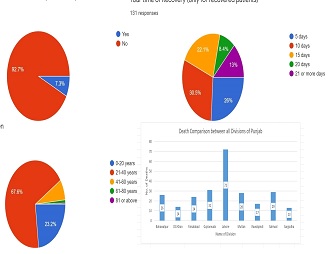Epidemiological and Clinical Manifestations of COVID-19 Variants in the Punjab Tertiary Care Hospitals
Abstract
 Abstract Views: 55
Abstract Views: 55
The first case of COVID-19 originated in China which then started spreading rapidly all over the world as a deadly pandemic. A huge number of people started to suffer due to the rapid attacks and virulent nature of the COVID-19 virus. This virus swiftly spreads from person to person. Initially considered as pneumonia due to similar signs and symptoms, with the passage of time its gravity was realized as compared to that of pneumonia. This virus attacks human respiratory system, damaging it to death. A survey was conducted during the pandemic to determine the prevalence and distribution of COVID-19 spread and its patient rate. Swabbed sticks were collected from different government and private hospitals following COVID-19 SOPs. A systematic data analysis was conducted by using different epidemiological tools to evaluate the prevalence and distribution rate of COVID across the country. Data was collected from all types of COVID-19 patients, including those on ventilator, admitted patients, patients with minor signs and symptoms, and patients having no symptoms but tested positive for COVID-19 by qRT-PCR. People who were already vaccinated were also included in this survey. A number of people showed positive vaccination effects, while most of them were not willing to receive vaccination. The study also illustrated that most of the patients who were admitted in hospitals showed severe symptoms, whereas some exhibited minor symptoms. It could be due to the fact that hospitals lack the facilities to accommodate every patient. Therefore, they only admit individuals with major symptoms and those having minor symptoms but with other complications. Whereas, patients with minor symptoms were referred to home isolation.
Downloads

Copyright (c) 2023 Muhammad Saad Bin Tahir, Muhammad Waseem, Muhammad Salman Ullah, Nageen Hussain, Faiza Kazmi, Munaza Rasheed, Aman Qammar

This work is licensed under a Creative Commons Attribution 4.0 International License.
BSR follows an open-access publishing policy and full text of all published articles is available free, immediately upon publication of an issue. The journal’s contents are published and distributed under the terms of the Creative Commons Attribution 4.0 International (CC-BY 4.0) license. Thus, the work submitted to the journal implies that it is original, unpublished work of the authors (neither published previously nor accepted/under consideration for publication elsewhere). On acceptance of a manuscript for publication, a corresponding author on the behalf of all co-authors of the manuscript will sign and submit a completed the Copyright and Author Consent Form.









